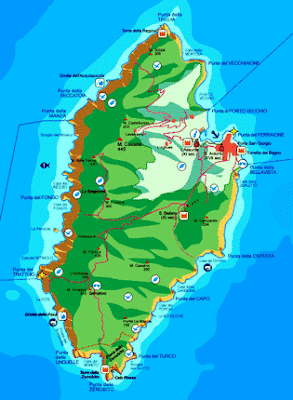
 Capraia, called Capraria in ancient times, is an island of Italy, part of the Tuscan Archipelago, off the northwest coast; it is also a comune (municipality) belonging to the Province of Livorno.
Capraia, called Capraria in ancient times, is an island of Italy, part of the Tuscan Archipelago, off the northwest coast; it is also a comune (municipality) belonging to the Province of Livorno.It is 62 km from the city of Livorno by sea, and 32 km northwest of the island of Elba; it is slightly closer (at 30 km) to the French island of Corsica.
It is of volcanic origin, has an area of 19 km² and its highest point is 466 m above sea level.
The island produces wine, and is a centre of the anchovy fishery. About 40 km to the north is the island of Gorgona, which is also famous for its anchovies.
The island is part of the Arcipelago Toscano National Park.
The island was called Aegylon (Αηγυλον) by the Greeks and then Capraria by the Romans, its name deriving perhaps from the presence of wild goats (Latina: capra). In the 4th century AD it housed a cenobium, where is the current church of St. Stephen.
In 1055 it was conquered by Saracen pirates, and later it was held by the Republic of Pisa. It become part of the Republic of Genoa after the Battle of Meloria, being assigned to the patrician Jacopo de Mari (1430) In 1540 the Genoese built here the Fortress of St. George (built in 1540 above a pre-existing fortification demolished by the African corsair Turgut Reis) and three coastal watch towers (Torre del Porto, 1541), Torre dello Zenobito, 1545, and Torre delle Barbici, 1699) against piracy. In 1767 it was occupied by Pasquale Paoli's troops.
In 1796 it was occupied for a short time by the British naval commander Horatio Nelson. After the annexation of the Republic of Genoa to the Kingdom of Sardinia decided by the Congress of Vienna in 1815, it was part of the province of Genoa until 1925, when it was moved to that of Livorno.
From 1873 to 1986 it was the seat of a penal colony.

Custom Search
If you liked this article, subscribe to the feed by clicking the image below to keep informed about new contents of the blog:














0 commenti:
Post a Comment